Recently I’ve seen a couple of memes wandering around my corner of the interwebs publishing a list called “John Wesley’s Manifesto.”
If you’re not familiar with the wondrous Reverend John Wesley, you’ve missed one of the more interesting figures in Anglo American religion. Born in 1703 (and died in 1791), Wesley was an Anglican priest who while remaining an Anglican accidentally started the Methodist church.
As to the manifesto, it is a remarkable document.
Sadly, he never actually published it.
However, it does contain his principles. They really are his principles garnered from various writings.
The first iteration of the list was compiled by the scholar Gary Best for a Methodist chapel founded by Wesley, the New Room in Bristol, England. The original document was titled “John Wesley’s principles in the 18th century.” And followed with the question “a political manifesto for today?”
- Reduce the gap between rich and poor
- Seek to ensure full employment
- Introduce measures to help the poorest, including a living wage
- Offer the best possible education
- Empower individuals to feel they can make a difference
- Promote tolerance
- Promote equal treatment for women
- Create a society based on values and not on profits and consumerism
- End all forms of enslavement
- Avoiding engaging in wars
- Avoid narrow self-interest and promote a world view
- Care for the animals with whom we share our planet.
A rather impressive list. The New Room provides a series of talks where the sources are cited.
It certainly can be enriched. I think of his call to end slavery, given our times, should include a call to end the cascade of ugly consequences that can follow generations after the fact of slavery ends. But, that totally acknowledged, oh my. What a person, this John Wesley. And. What a call…
I feel it a call to my heart.
Maybe yours, as well?
And at no extra charge, a little gift from John’s brother Charles…













